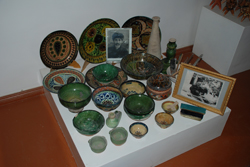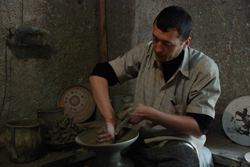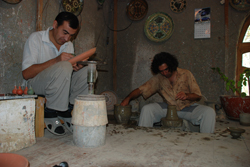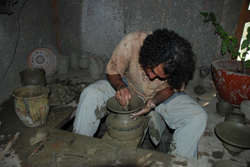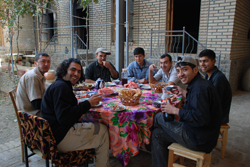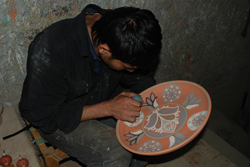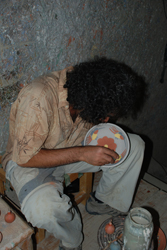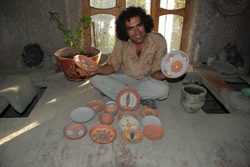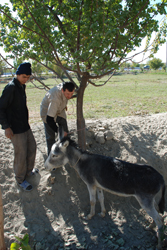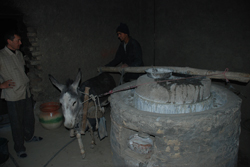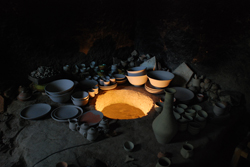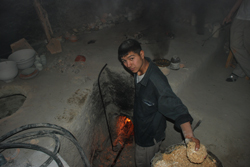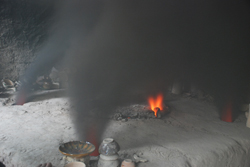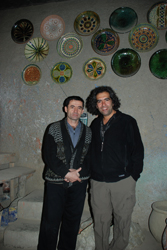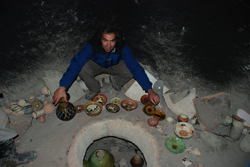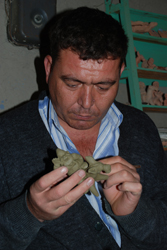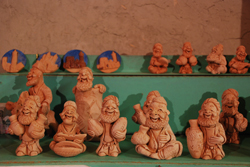Ranagul the potter donkey
20 October, 2008, 03:36 am in "Uzbekistan"
I love meeting local potters and if possible working a few days with them and learning their techniques of making pots and preparing their own clay. I didn't find any pottery workshops in Kazakhstan, Kyrgyzstan and Tajikistan. However, I found lots of information about pottery in Uzbekistan. Geographically, Uzbekistan is a flat country with lots of red clay which makes it a good place for potters.
While Tamia and I were looking at an art store, Tamia found a brochure for the Gijduvan Ceramic Museum. I looked at their web page and found out that they had program for teaching traditional ceramics.
For our first day in Bukhara, we went to Gijduvan which was an important trade and crafts center on silk road. Gijduvan is about 48 km north of Bukhara and requires two buses to get there. The road to Gijduvan runs by lots of cotton fields and farms which made the trip very interesting. The museum/workshop building was made up of several rooms surrounding a courtyard. During our visit, Hassan (one of the students) walked us through the very well organized musuem. After talking to him, I decided to spend four days at the workshop.
The first day, Hassan (my teacher) showed me how to use their wheel and asked me if I have ever riden a horse since they called the seat "Horse back". In the next few days I trimmed the pieces and glazed them. There were two colors (red or oxide and white) for the base glaze and 5-6 other colors for the design. I like the mixture of the colors they use a lot which made the pots so different and unique. The other members of the school were so helpful and we had lots of fun speaking in both Tajiki and Uzbek.
While Tamia and I were looking at an art store, Tamia found a brochure for the Gijduvan Ceramic Museum. I looked at their web page and found out that they had program for teaching traditional ceramics.
For our first day in Bukhara, we went to Gijduvan which was an important trade and crafts center on silk road. Gijduvan is about 48 km north of Bukhara and requires two buses to get there. The road to Gijduvan runs by lots of cotton fields and farms which made the trip very interesting. The museum/workshop building was made up of several rooms surrounding a courtyard. During our visit, Hassan (one of the students) walked us through the very well organized musuem. After talking to him, I decided to spend four days at the workshop.
The first day, Hassan (my teacher) showed me how to use their wheel and asked me if I have ever riden a horse since they called the seat "Horse back". In the next few days I trimmed the pieces and glazed them. There were two colors (red or oxide and white) for the base glaze and 5-6 other colors for the design. I like the mixture of the colors they use a lot which made the pots so different and unique. The other members of the school were so helpful and we had lots of fun speaking in both Tajiki and Uzbek.
A highlight was when Hassan brought Ranagul (the potter donkey) for grinding glazes. Ranagul works 8 hours a month. On other days she is attached to the wheel just so tourists can take her photos. Ranagul also served as the workshop clock by braying every 15 minutes and whenever she saw me.
While I was studying, various groups of tourists came to visit the school.The kiln room was full of black smoke from the kindling used for firing.
The day when Tamia and I went to take the finished pots, I had a chance to meet with the director of the school (Mr. Abdullo Narzullaev) who had been in France for an art exhebition. He told me about a group of Afghans from a village (Istafil) north of Kabul who studied ceramics in Gijduvan and gave me their contact information. He also told me about ceramics made by women in Badakhshan (Tajikistan). Unfortunately he didn't know how to contact them or even if they were still working.
Gijduvan was a wonderful experience for me and I am so happy that I could also make new friends.
Back in town, we found another ceramics workshop. The artist (Azamet) there specialized in comic sculptures of Uzbek people, especially Nasredin Hoca, eating melon, playing music, making bread, or riding donkeys. He also made some whimsical 3 headed dragons. He had studied in Gijduvan and shared the workshop with one of the Narzullaev brothers, the family that owned the ceramics museum.
Comments
- Comments
Powered by My Blog 1.69. Copyright 2003-2006 FuzzyMonkey.net.
Created by the scripting wizards at FuzzyMonkey.net..
(Code modified by Rowshan Dowlatabadi)
Created by the scripting wizards at FuzzyMonkey.net..
(Code modified by Rowshan Dowlatabadi)


